Corporate Governance Assignment
VerifiedAdded on 2021/05/31
|14
|4258
|27
AI Summary
Contribute Materials
Your contribution can guide someone’s learning journey. Share your
documents today.
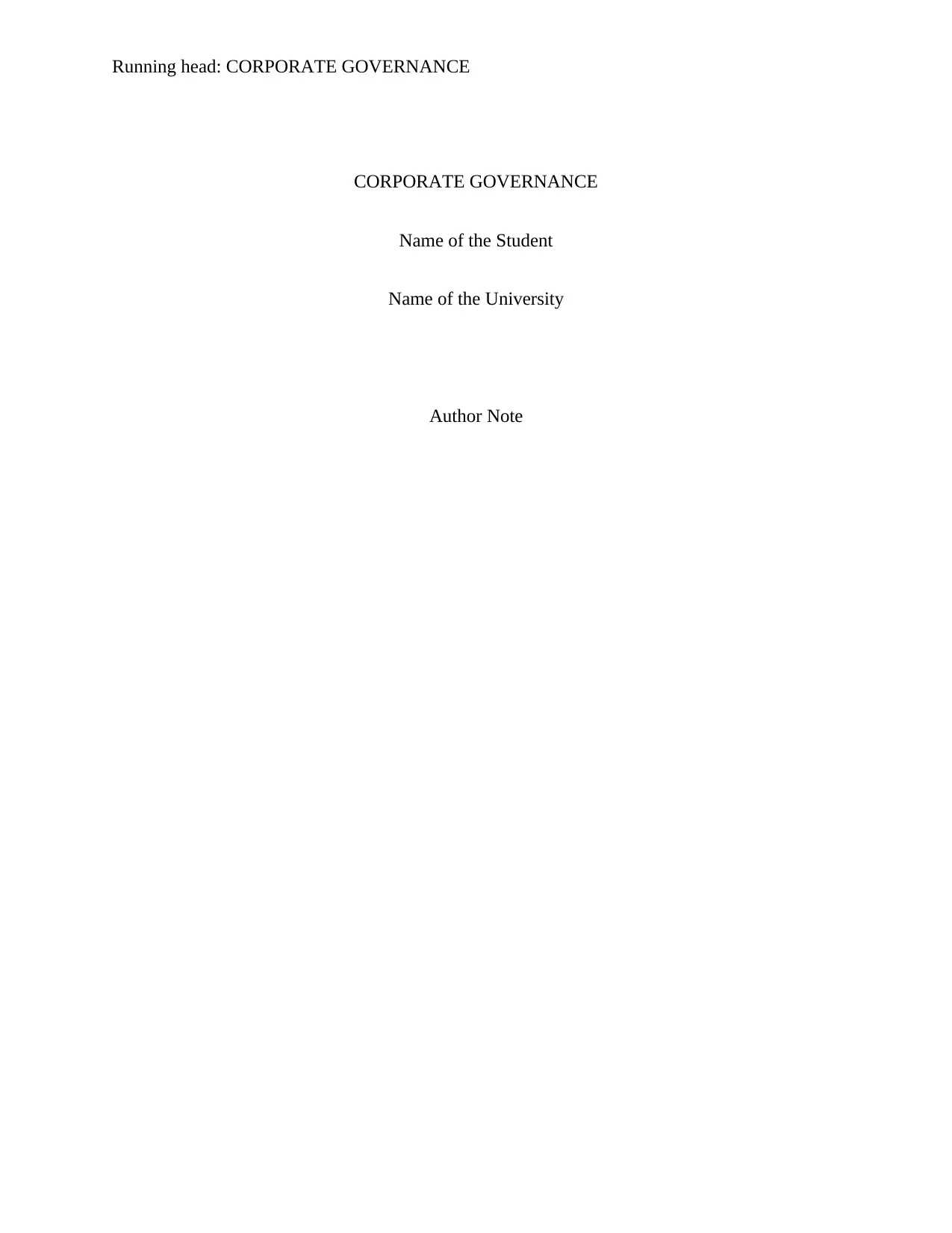
Running head: CORPORATE GOVERNANCE
CORPORATE GOVERNANCE
Name of the Student
Name of the University
Author Note
CORPORATE GOVERNANCE
Name of the Student
Name of the University
Author Note
Secure Best Marks with AI Grader
Need help grading? Try our AI Grader for instant feedback on your assignments.
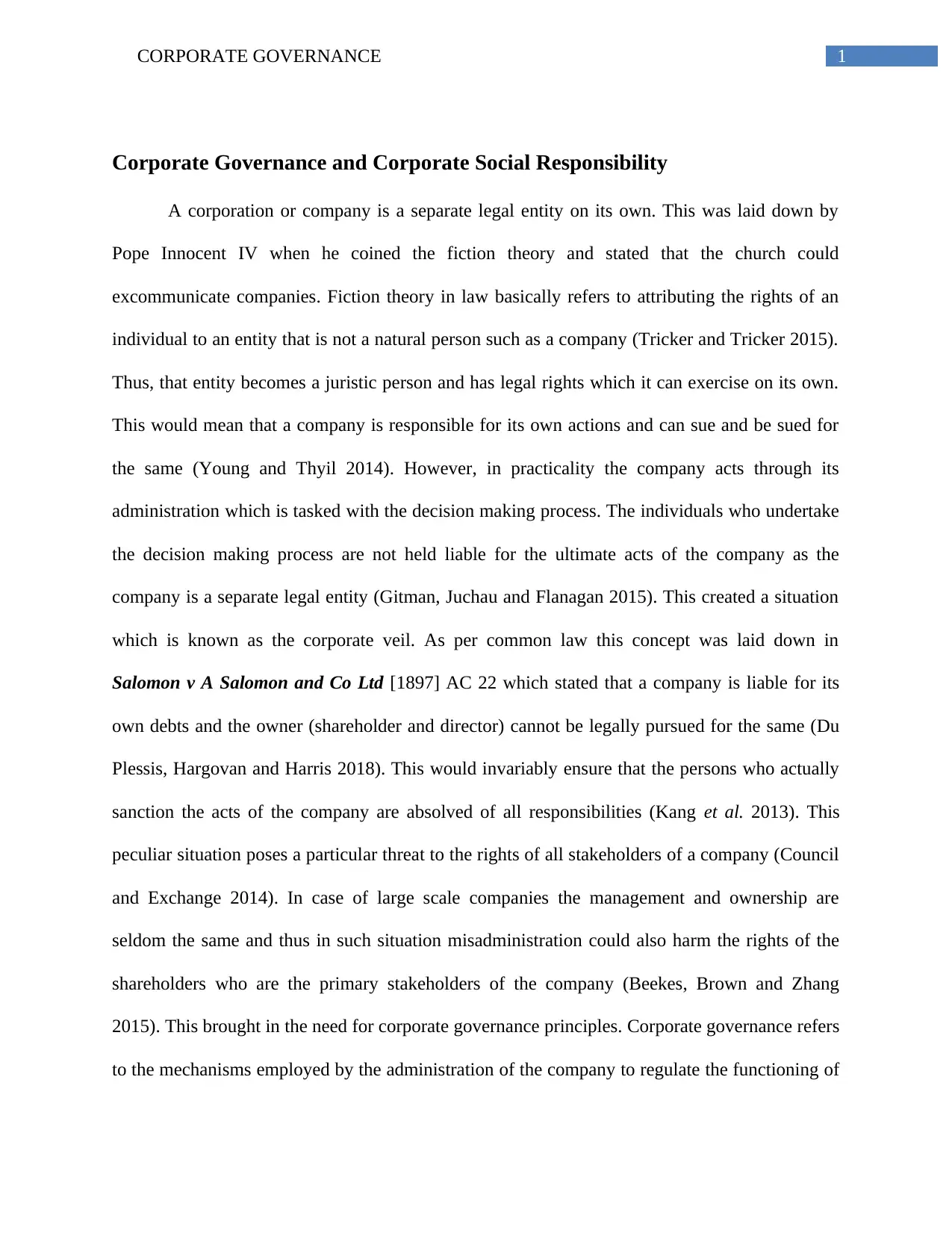
1CORPORATE GOVERNANCE
Corporate Governance and Corporate Social Responsibility
A corporation or company is a separate legal entity on its own. This was laid down by
Pope Innocent IV when he coined the fiction theory and stated that the church could
excommunicate companies. Fiction theory in law basically refers to attributing the rights of an
individual to an entity that is not a natural person such as a company (Tricker and Tricker 2015).
Thus, that entity becomes a juristic person and has legal rights which it can exercise on its own.
This would mean that a company is responsible for its own actions and can sue and be sued for
the same (Young and Thyil 2014). However, in practicality the company acts through its
administration which is tasked with the decision making process. The individuals who undertake
the decision making process are not held liable for the ultimate acts of the company as the
company is a separate legal entity (Gitman, Juchau and Flanagan 2015). This created a situation
which is known as the corporate veil. As per common law this concept was laid down in
Salomon v A Salomon and Co Ltd [1897] AC 22 which stated that a company is liable for its
own debts and the owner (shareholder and director) cannot be legally pursued for the same (Du
Plessis, Hargovan and Harris 2018). This would invariably ensure that the persons who actually
sanction the acts of the company are absolved of all responsibilities (Kang et al. 2013). This
peculiar situation poses a particular threat to the rights of all stakeholders of a company (Council
and Exchange 2014). In case of large scale companies the management and ownership are
seldom the same and thus in such situation misadministration could also harm the rights of the
shareholders who are the primary stakeholders of the company (Beekes, Brown and Zhang
2015). This brought in the need for corporate governance principles. Corporate governance refers
to the mechanisms employed by the administration of the company to regulate the functioning of
Corporate Governance and Corporate Social Responsibility
A corporation or company is a separate legal entity on its own. This was laid down by
Pope Innocent IV when he coined the fiction theory and stated that the church could
excommunicate companies. Fiction theory in law basically refers to attributing the rights of an
individual to an entity that is not a natural person such as a company (Tricker and Tricker 2015).
Thus, that entity becomes a juristic person and has legal rights which it can exercise on its own.
This would mean that a company is responsible for its own actions and can sue and be sued for
the same (Young and Thyil 2014). However, in practicality the company acts through its
administration which is tasked with the decision making process. The individuals who undertake
the decision making process are not held liable for the ultimate acts of the company as the
company is a separate legal entity (Gitman, Juchau and Flanagan 2015). This created a situation
which is known as the corporate veil. As per common law this concept was laid down in
Salomon v A Salomon and Co Ltd [1897] AC 22 which stated that a company is liable for its
own debts and the owner (shareholder and director) cannot be legally pursued for the same (Du
Plessis, Hargovan and Harris 2018). This would invariably ensure that the persons who actually
sanction the acts of the company are absolved of all responsibilities (Kang et al. 2013). This
peculiar situation poses a particular threat to the rights of all stakeholders of a company (Council
and Exchange 2014). In case of large scale companies the management and ownership are
seldom the same and thus in such situation misadministration could also harm the rights of the
shareholders who are the primary stakeholders of the company (Beekes, Brown and Zhang
2015). This brought in the need for corporate governance principles. Corporate governance refers
to the mechanisms employed by the administration of the company to regulate the functioning of
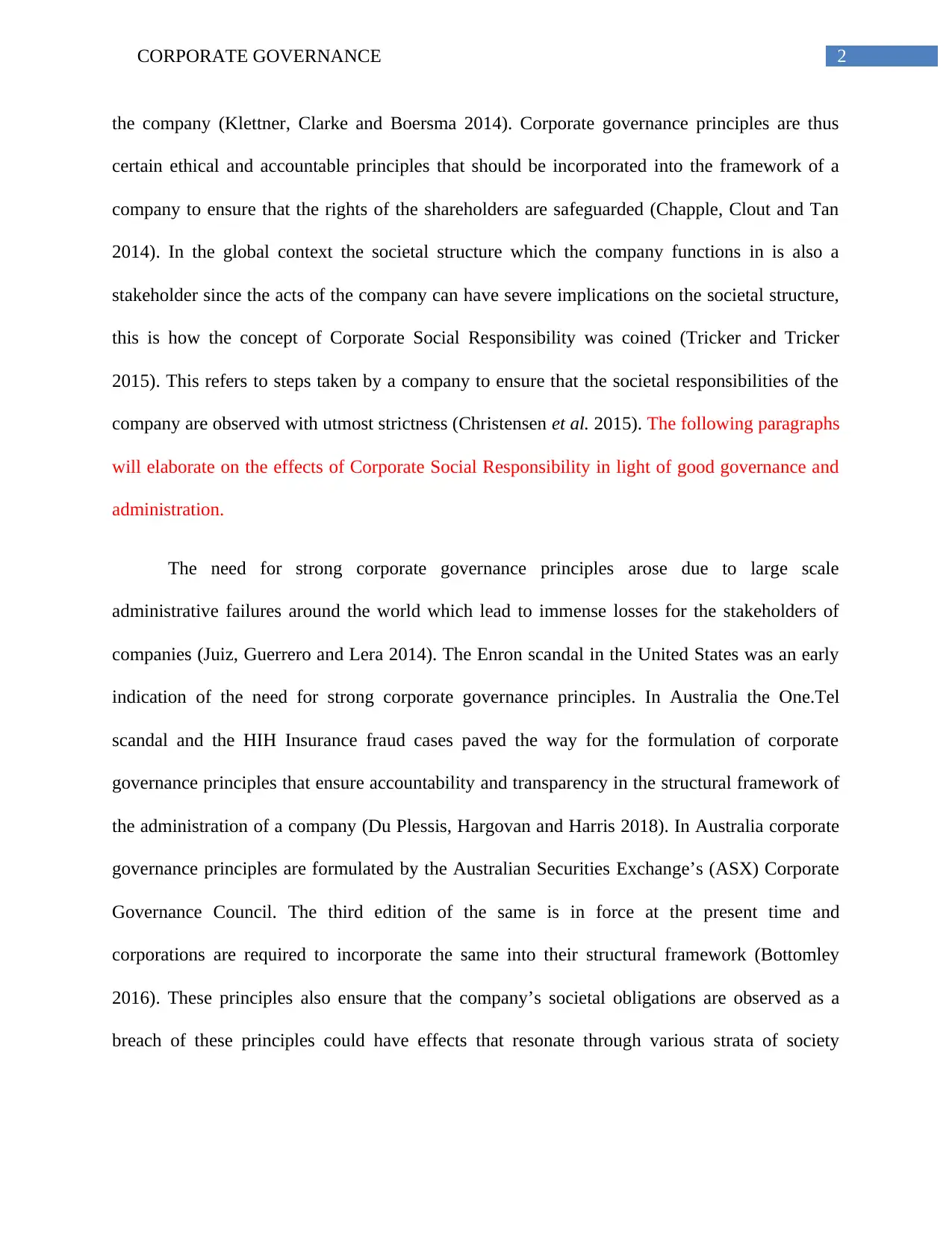
2CORPORATE GOVERNANCE
the company (Klettner, Clarke and Boersma 2014). Corporate governance principles are thus
certain ethical and accountable principles that should be incorporated into the framework of a
company to ensure that the rights of the shareholders are safeguarded (Chapple, Clout and Tan
2014). In the global context the societal structure which the company functions in is also a
stakeholder since the acts of the company can have severe implications on the societal structure,
this is how the concept of Corporate Social Responsibility was coined (Tricker and Tricker
2015). This refers to steps taken by a company to ensure that the societal responsibilities of the
company are observed with utmost strictness (Christensen et al. 2015). The following paragraphs
will elaborate on the effects of Corporate Social Responsibility in light of good governance and
administration.
The need for strong corporate governance principles arose due to large scale
administrative failures around the world which lead to immense losses for the stakeholders of
companies (Juiz, Guerrero and Lera 2014). The Enron scandal in the United States was an early
indication of the need for strong corporate governance principles. In Australia the One.Tel
scandal and the HIH Insurance fraud cases paved the way for the formulation of corporate
governance principles that ensure accountability and transparency in the structural framework of
the administration of a company (Du Plessis, Hargovan and Harris 2018). In Australia corporate
governance principles are formulated by the Australian Securities Exchange’s (ASX) Corporate
Governance Council. The third edition of the same is in force at the present time and
corporations are required to incorporate the same into their structural framework (Bottomley
2016). These principles also ensure that the company’s societal obligations are observed as a
breach of these principles could have effects that resonate through various strata of society
the company (Klettner, Clarke and Boersma 2014). Corporate governance principles are thus
certain ethical and accountable principles that should be incorporated into the framework of a
company to ensure that the rights of the shareholders are safeguarded (Chapple, Clout and Tan
2014). In the global context the societal structure which the company functions in is also a
stakeholder since the acts of the company can have severe implications on the societal structure,
this is how the concept of Corporate Social Responsibility was coined (Tricker and Tricker
2015). This refers to steps taken by a company to ensure that the societal responsibilities of the
company are observed with utmost strictness (Christensen et al. 2015). The following paragraphs
will elaborate on the effects of Corporate Social Responsibility in light of good governance and
administration.
The need for strong corporate governance principles arose due to large scale
administrative failures around the world which lead to immense losses for the stakeholders of
companies (Juiz, Guerrero and Lera 2014). The Enron scandal in the United States was an early
indication of the need for strong corporate governance principles. In Australia the One.Tel
scandal and the HIH Insurance fraud cases paved the way for the formulation of corporate
governance principles that ensure accountability and transparency in the structural framework of
the administration of a company (Du Plessis, Hargovan and Harris 2018). In Australia corporate
governance principles are formulated by the Australian Securities Exchange’s (ASX) Corporate
Governance Council. The third edition of the same is in force at the present time and
corporations are required to incorporate the same into their structural framework (Bottomley
2016). These principles also ensure that the company’s societal obligations are observed as a
breach of these principles could have effects that resonate through various strata of society
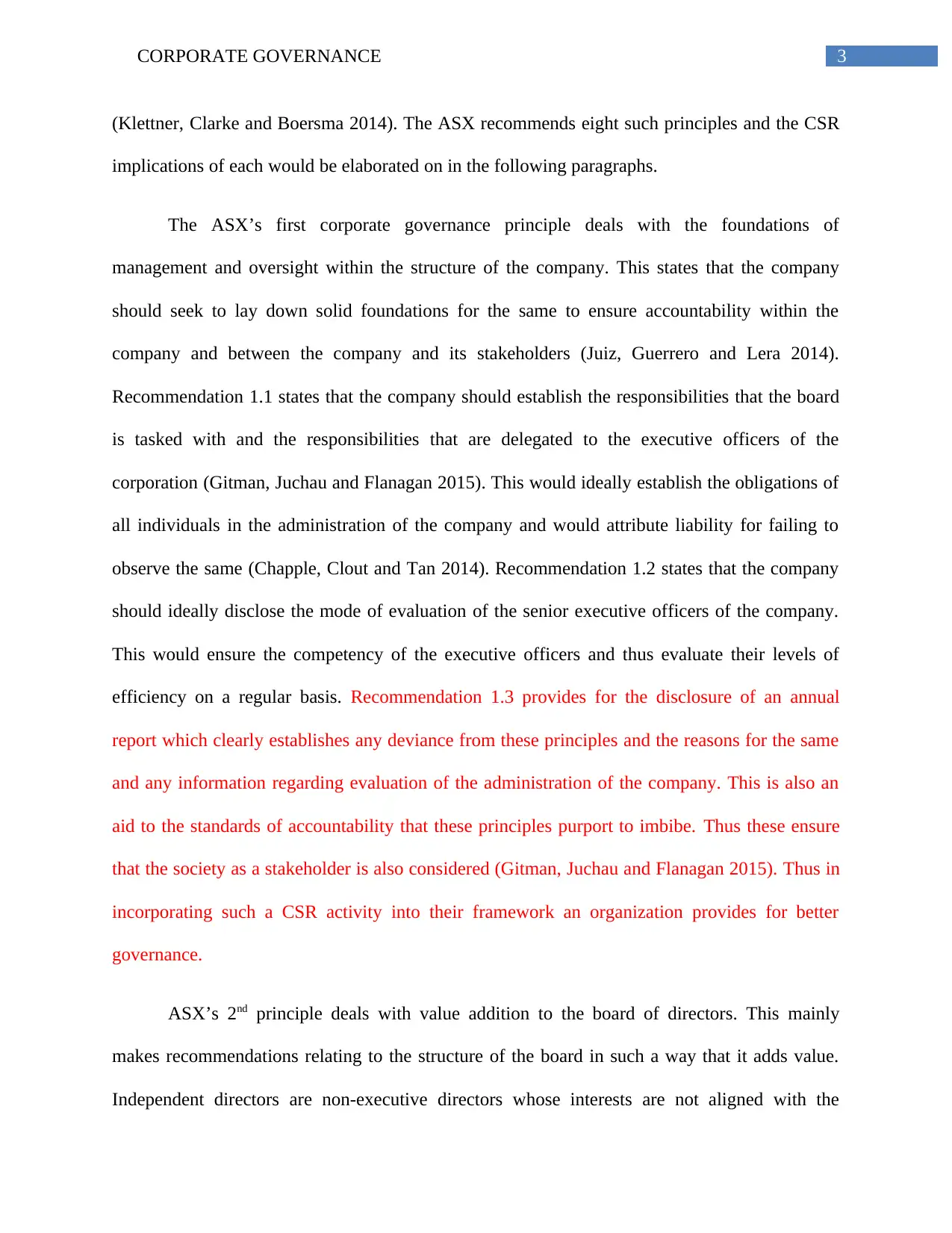
3CORPORATE GOVERNANCE
(Klettner, Clarke and Boersma 2014). The ASX recommends eight such principles and the CSR
implications of each would be elaborated on in the following paragraphs.
The ASX’s first corporate governance principle deals with the foundations of
management and oversight within the structure of the company. This states that the company
should seek to lay down solid foundations for the same to ensure accountability within the
company and between the company and its stakeholders (Juiz, Guerrero and Lera 2014).
Recommendation 1.1 states that the company should establish the responsibilities that the board
is tasked with and the responsibilities that are delegated to the executive officers of the
corporation (Gitman, Juchau and Flanagan 2015). This would ideally establish the obligations of
all individuals in the administration of the company and would attribute liability for failing to
observe the same (Chapple, Clout and Tan 2014). Recommendation 1.2 states that the company
should ideally disclose the mode of evaluation of the senior executive officers of the company.
This would ensure the competency of the executive officers and thus evaluate their levels of
efficiency on a regular basis. Recommendation 1.3 provides for the disclosure of an annual
report which clearly establishes any deviance from these principles and the reasons for the same
and any information regarding evaluation of the administration of the company. This is also an
aid to the standards of accountability that these principles purport to imbibe. Thus these ensure
that the society as a stakeholder is also considered (Gitman, Juchau and Flanagan 2015). Thus in
incorporating such a CSR activity into their framework an organization provides for better
governance.
ASX’s 2nd principle deals with value addition to the board of directors. This mainly
makes recommendations relating to the structure of the board in such a way that it adds value.
Independent directors are non-executive directors whose interests are not aligned with the
(Klettner, Clarke and Boersma 2014). The ASX recommends eight such principles and the CSR
implications of each would be elaborated on in the following paragraphs.
The ASX’s first corporate governance principle deals with the foundations of
management and oversight within the structure of the company. This states that the company
should seek to lay down solid foundations for the same to ensure accountability within the
company and between the company and its stakeholders (Juiz, Guerrero and Lera 2014).
Recommendation 1.1 states that the company should establish the responsibilities that the board
is tasked with and the responsibilities that are delegated to the executive officers of the
corporation (Gitman, Juchau and Flanagan 2015). This would ideally establish the obligations of
all individuals in the administration of the company and would attribute liability for failing to
observe the same (Chapple, Clout and Tan 2014). Recommendation 1.2 states that the company
should ideally disclose the mode of evaluation of the senior executive officers of the company.
This would ensure the competency of the executive officers and thus evaluate their levels of
efficiency on a regular basis. Recommendation 1.3 provides for the disclosure of an annual
report which clearly establishes any deviance from these principles and the reasons for the same
and any information regarding evaluation of the administration of the company. This is also an
aid to the standards of accountability that these principles purport to imbibe. Thus these ensure
that the society as a stakeholder is also considered (Gitman, Juchau and Flanagan 2015). Thus in
incorporating such a CSR activity into their framework an organization provides for better
governance.
ASX’s 2nd principle deals with value addition to the board of directors. This mainly
makes recommendations relating to the structure of the board in such a way that it adds value.
Independent directors are non-executive directors whose interests are not aligned with the
Secure Best Marks with AI Grader
Need help grading? Try our AI Grader for instant feedback on your assignments.
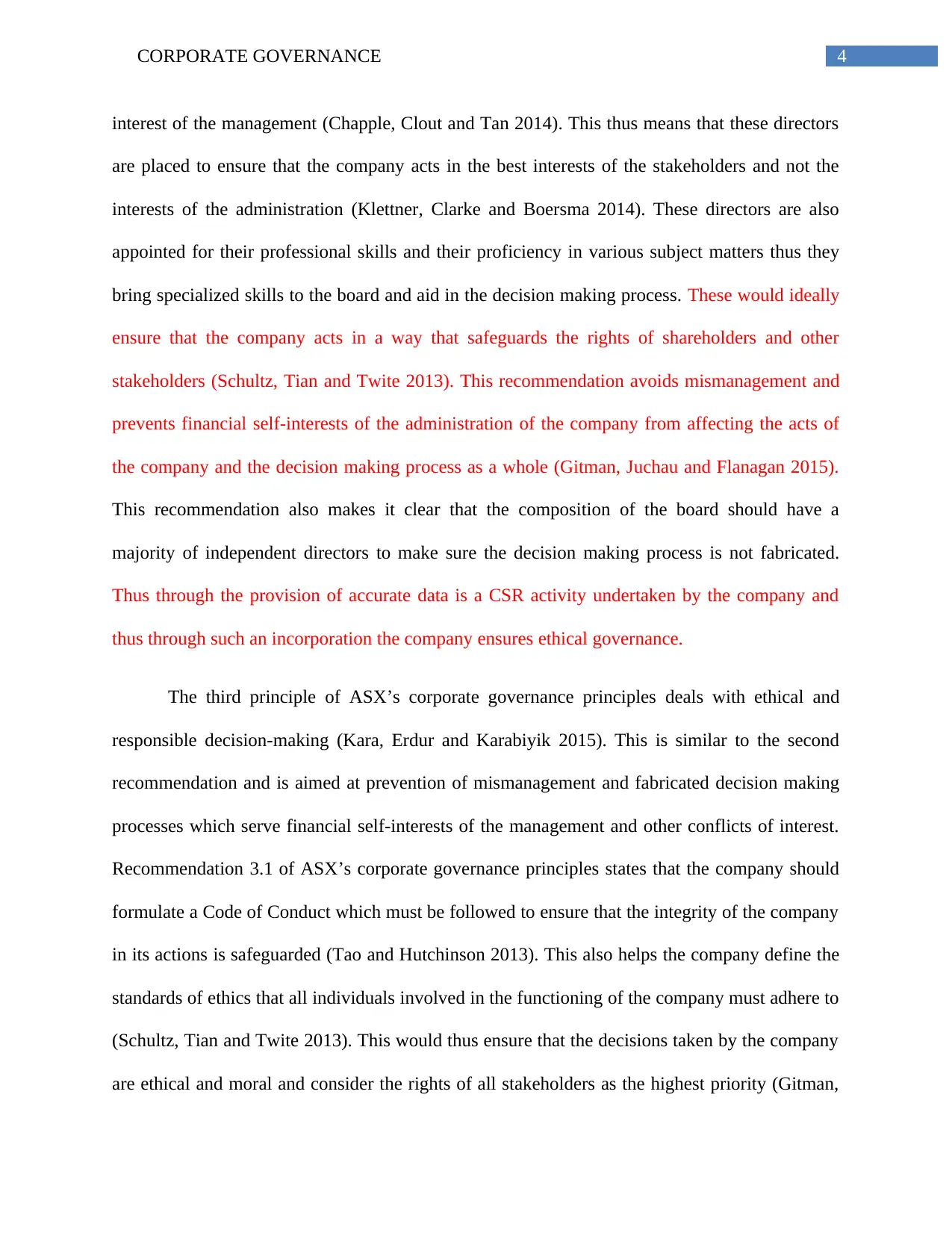
4CORPORATE GOVERNANCE
interest of the management (Chapple, Clout and Tan 2014). This thus means that these directors
are placed to ensure that the company acts in the best interests of the stakeholders and not the
interests of the administration (Klettner, Clarke and Boersma 2014). These directors are also
appointed for their professional skills and their proficiency in various subject matters thus they
bring specialized skills to the board and aid in the decision making process. These would ideally
ensure that the company acts in a way that safeguards the rights of shareholders and other
stakeholders (Schultz, Tian and Twite 2013). This recommendation avoids mismanagement and
prevents financial self-interests of the administration of the company from affecting the acts of
the company and the decision making process as a whole (Gitman, Juchau and Flanagan 2015).
This recommendation also makes it clear that the composition of the board should have a
majority of independent directors to make sure the decision making process is not fabricated.
Thus through the provision of accurate data is a CSR activity undertaken by the company and
thus through such an incorporation the company ensures ethical governance.
The third principle of ASX’s corporate governance principles deals with ethical and
responsible decision-making (Kara, Erdur and Karabiyik 2015). This is similar to the second
recommendation and is aimed at prevention of mismanagement and fabricated decision making
processes which serve financial self-interests of the management and other conflicts of interest.
Recommendation 3.1 of ASX’s corporate governance principles states that the company should
formulate a Code of Conduct which must be followed to ensure that the integrity of the company
in its actions is safeguarded (Tao and Hutchinson 2013). This also helps the company define the
standards of ethics that all individuals involved in the functioning of the company must adhere to
(Schultz, Tian and Twite 2013). This would thus ensure that the decisions taken by the company
are ethical and moral and consider the rights of all stakeholders as the highest priority (Gitman,
interest of the management (Chapple, Clout and Tan 2014). This thus means that these directors
are placed to ensure that the company acts in the best interests of the stakeholders and not the
interests of the administration (Klettner, Clarke and Boersma 2014). These directors are also
appointed for their professional skills and their proficiency in various subject matters thus they
bring specialized skills to the board and aid in the decision making process. These would ideally
ensure that the company acts in a way that safeguards the rights of shareholders and other
stakeholders (Schultz, Tian and Twite 2013). This recommendation avoids mismanagement and
prevents financial self-interests of the administration of the company from affecting the acts of
the company and the decision making process as a whole (Gitman, Juchau and Flanagan 2015).
This recommendation also makes it clear that the composition of the board should have a
majority of independent directors to make sure the decision making process is not fabricated.
Thus through the provision of accurate data is a CSR activity undertaken by the company and
thus through such an incorporation the company ensures ethical governance.
The third principle of ASX’s corporate governance principles deals with ethical and
responsible decision-making (Kara, Erdur and Karabiyik 2015). This is similar to the second
recommendation and is aimed at prevention of mismanagement and fabricated decision making
processes which serve financial self-interests of the management and other conflicts of interest.
Recommendation 3.1 of ASX’s corporate governance principles states that the company should
formulate a Code of Conduct which must be followed to ensure that the integrity of the company
in its actions is safeguarded (Tao and Hutchinson 2013). This also helps the company define the
standards of ethics that all individuals involved in the functioning of the company must adhere to
(Schultz, Tian and Twite 2013). This would thus ensure that the decisions taken by the company
are ethical and moral and consider the rights of all stakeholders as the highest priority (Gitman,
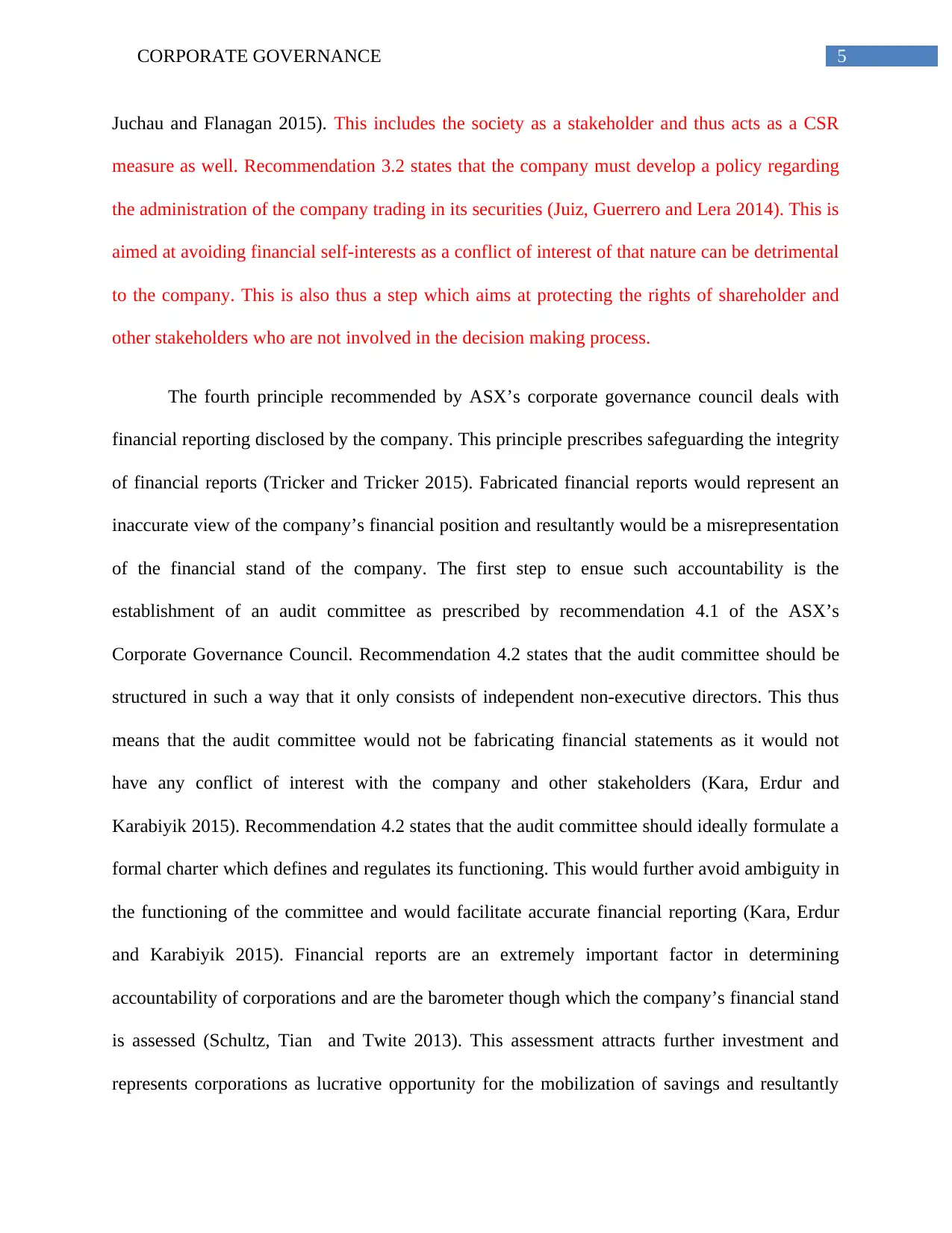
5CORPORATE GOVERNANCE
Juchau and Flanagan 2015). This includes the society as a stakeholder and thus acts as a CSR
measure as well. Recommendation 3.2 states that the company must develop a policy regarding
the administration of the company trading in its securities (Juiz, Guerrero and Lera 2014). This is
aimed at avoiding financial self-interests as a conflict of interest of that nature can be detrimental
to the company. This is also thus a step which aims at protecting the rights of shareholder and
other stakeholders who are not involved in the decision making process.
The fourth principle recommended by ASX’s corporate governance council deals with
financial reporting disclosed by the company. This principle prescribes safeguarding the integrity
of financial reports (Tricker and Tricker 2015). Fabricated financial reports would represent an
inaccurate view of the company’s financial position and resultantly would be a misrepresentation
of the financial stand of the company. The first step to ensue such accountability is the
establishment of an audit committee as prescribed by recommendation 4.1 of the ASX’s
Corporate Governance Council. Recommendation 4.2 states that the audit committee should be
structured in such a way that it only consists of independent non-executive directors. This thus
means that the audit committee would not be fabricating financial statements as it would not
have any conflict of interest with the company and other stakeholders (Kara, Erdur and
Karabiyik 2015). Recommendation 4.2 states that the audit committee should ideally formulate a
formal charter which defines and regulates its functioning. This would further avoid ambiguity in
the functioning of the committee and would facilitate accurate financial reporting (Kara, Erdur
and Karabiyik 2015). Financial reports are an extremely important factor in determining
accountability of corporations and are the barometer though which the company’s financial stand
is assessed (Schultz, Tian and Twite 2013). This assessment attracts further investment and
represents corporations as lucrative opportunity for the mobilization of savings and resultantly
Juchau and Flanagan 2015). This includes the society as a stakeholder and thus acts as a CSR
measure as well. Recommendation 3.2 states that the company must develop a policy regarding
the administration of the company trading in its securities (Juiz, Guerrero and Lera 2014). This is
aimed at avoiding financial self-interests as a conflict of interest of that nature can be detrimental
to the company. This is also thus a step which aims at protecting the rights of shareholder and
other stakeholders who are not involved in the decision making process.
The fourth principle recommended by ASX’s corporate governance council deals with
financial reporting disclosed by the company. This principle prescribes safeguarding the integrity
of financial reports (Tricker and Tricker 2015). Fabricated financial reports would represent an
inaccurate view of the company’s financial position and resultantly would be a misrepresentation
of the financial stand of the company. The first step to ensue such accountability is the
establishment of an audit committee as prescribed by recommendation 4.1 of the ASX’s
Corporate Governance Council. Recommendation 4.2 states that the audit committee should be
structured in such a way that it only consists of independent non-executive directors. This thus
means that the audit committee would not be fabricating financial statements as it would not
have any conflict of interest with the company and other stakeholders (Kara, Erdur and
Karabiyik 2015). Recommendation 4.2 states that the audit committee should ideally formulate a
formal charter which defines and regulates its functioning. This would further avoid ambiguity in
the functioning of the committee and would facilitate accurate financial reporting (Kara, Erdur
and Karabiyik 2015). Financial reports are an extremely important factor in determining
accountability of corporations and are the barometer though which the company’s financial stand
is assessed (Schultz, Tian and Twite 2013). This assessment attracts further investment and
represents corporations as lucrative opportunity for the mobilization of savings and resultantly
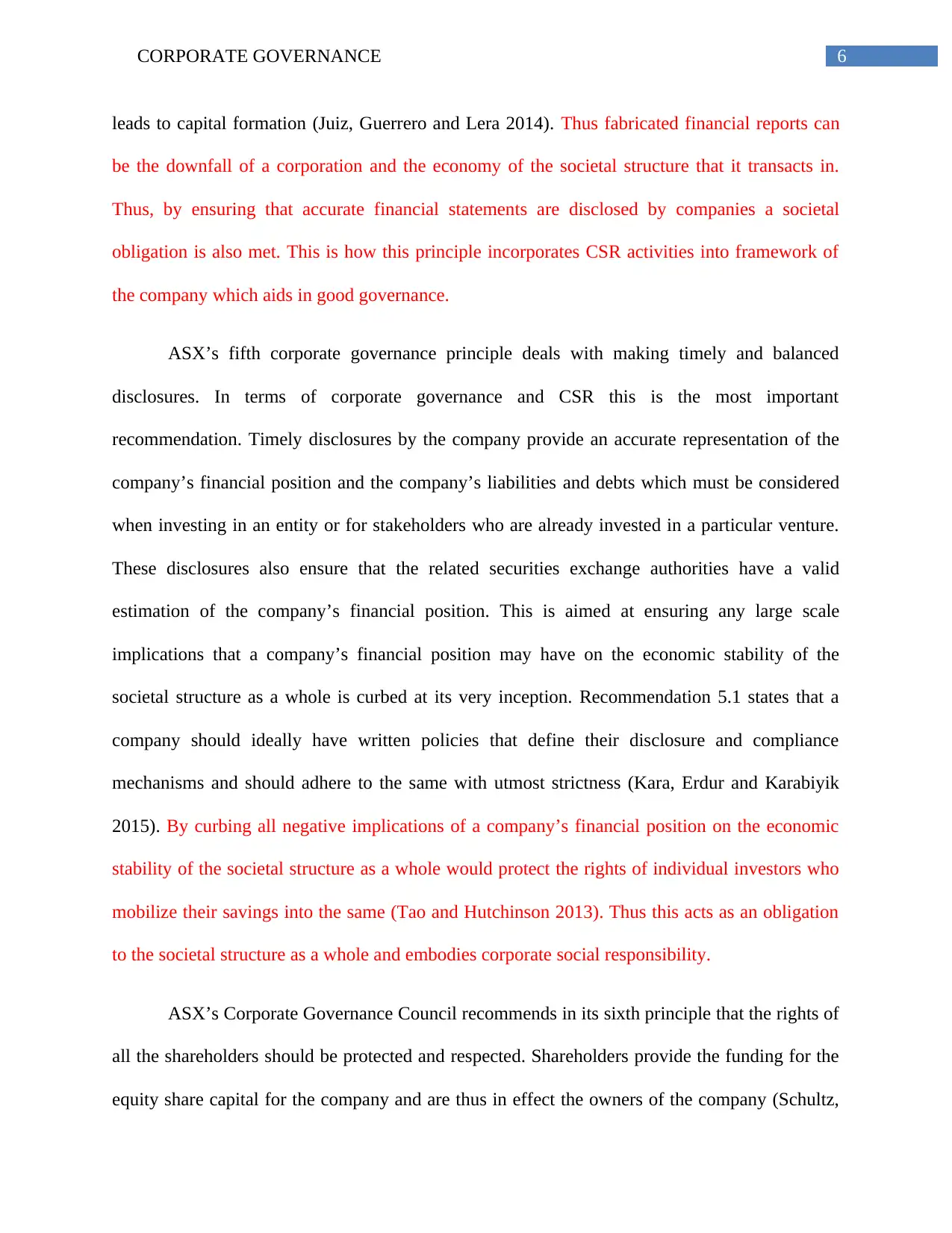
6CORPORATE GOVERNANCE
leads to capital formation (Juiz, Guerrero and Lera 2014). Thus fabricated financial reports can
be the downfall of a corporation and the economy of the societal structure that it transacts in.
Thus, by ensuring that accurate financial statements are disclosed by companies a societal
obligation is also met. This is how this principle incorporates CSR activities into framework of
the company which aids in good governance.
ASX’s fifth corporate governance principle deals with making timely and balanced
disclosures. In terms of corporate governance and CSR this is the most important
recommendation. Timely disclosures by the company provide an accurate representation of the
company’s financial position and the company’s liabilities and debts which must be considered
when investing in an entity or for stakeholders who are already invested in a particular venture.
These disclosures also ensure that the related securities exchange authorities have a valid
estimation of the company’s financial position. This is aimed at ensuring any large scale
implications that a company’s financial position may have on the economic stability of the
societal structure as a whole is curbed at its very inception. Recommendation 5.1 states that a
company should ideally have written policies that define their disclosure and compliance
mechanisms and should adhere to the same with utmost strictness (Kara, Erdur and Karabiyik
2015). By curbing all negative implications of a company’s financial position on the economic
stability of the societal structure as a whole would protect the rights of individual investors who
mobilize their savings into the same (Tao and Hutchinson 2013). Thus this acts as an obligation
to the societal structure as a whole and embodies corporate social responsibility.
ASX’s Corporate Governance Council recommends in its sixth principle that the rights of
all the shareholders should be protected and respected. Shareholders provide the funding for the
equity share capital for the company and are thus in effect the owners of the company (Schultz,
leads to capital formation (Juiz, Guerrero and Lera 2014). Thus fabricated financial reports can
be the downfall of a corporation and the economy of the societal structure that it transacts in.
Thus, by ensuring that accurate financial statements are disclosed by companies a societal
obligation is also met. This is how this principle incorporates CSR activities into framework of
the company which aids in good governance.
ASX’s fifth corporate governance principle deals with making timely and balanced
disclosures. In terms of corporate governance and CSR this is the most important
recommendation. Timely disclosures by the company provide an accurate representation of the
company’s financial position and the company’s liabilities and debts which must be considered
when investing in an entity or for stakeholders who are already invested in a particular venture.
These disclosures also ensure that the related securities exchange authorities have a valid
estimation of the company’s financial position. This is aimed at ensuring any large scale
implications that a company’s financial position may have on the economic stability of the
societal structure as a whole is curbed at its very inception. Recommendation 5.1 states that a
company should ideally have written policies that define their disclosure and compliance
mechanisms and should adhere to the same with utmost strictness (Kara, Erdur and Karabiyik
2015). By curbing all negative implications of a company’s financial position on the economic
stability of the societal structure as a whole would protect the rights of individual investors who
mobilize their savings into the same (Tao and Hutchinson 2013). Thus this acts as an obligation
to the societal structure as a whole and embodies corporate social responsibility.
ASX’s Corporate Governance Council recommends in its sixth principle that the rights of
all the shareholders should be protected and respected. Shareholders provide the funding for the
equity share capital for the company and are thus in effect the owners of the company (Schultz,
Paraphrase This Document
Need a fresh take? Get an instant paraphrase of this document with our AI Paraphraser
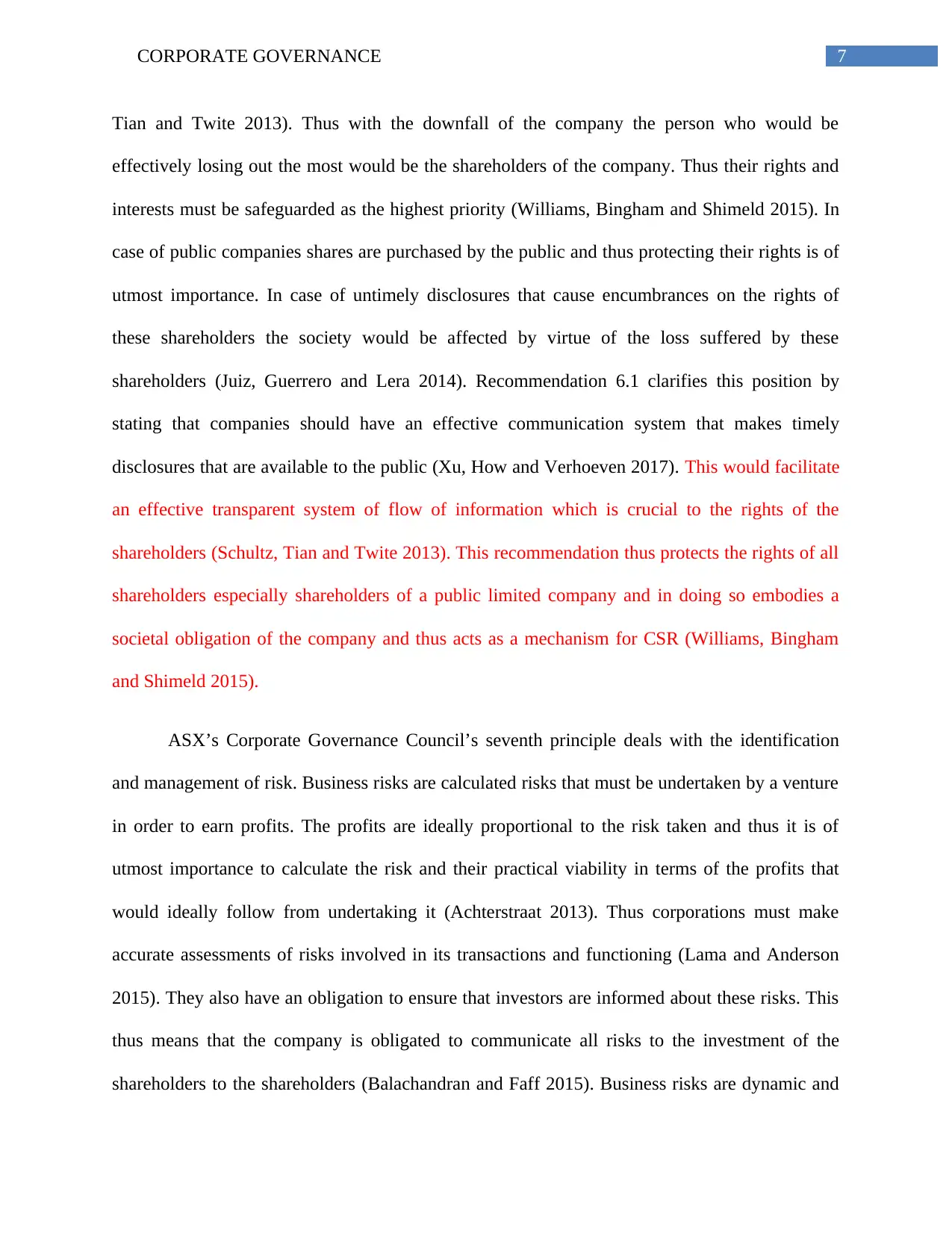
7CORPORATE GOVERNANCE
Tian and Twite 2013). Thus with the downfall of the company the person who would be
effectively losing out the most would be the shareholders of the company. Thus their rights and
interests must be safeguarded as the highest priority (Williams, Bingham and Shimeld 2015). In
case of public companies shares are purchased by the public and thus protecting their rights is of
utmost importance. In case of untimely disclosures that cause encumbrances on the rights of
these shareholders the society would be affected by virtue of the loss suffered by these
shareholders (Juiz, Guerrero and Lera 2014). Recommendation 6.1 clarifies this position by
stating that companies should have an effective communication system that makes timely
disclosures that are available to the public (Xu, How and Verhoeven 2017). This would facilitate
an effective transparent system of flow of information which is crucial to the rights of the
shareholders (Schultz, Tian and Twite 2013). This recommendation thus protects the rights of all
shareholders especially shareholders of a public limited company and in doing so embodies a
societal obligation of the company and thus acts as a mechanism for CSR (Williams, Bingham
and Shimeld 2015).
ASX’s Corporate Governance Council’s seventh principle deals with the identification
and management of risk. Business risks are calculated risks that must be undertaken by a venture
in order to earn profits. The profits are ideally proportional to the risk taken and thus it is of
utmost importance to calculate the risk and their practical viability in terms of the profits that
would ideally follow from undertaking it (Achterstraat 2013). Thus corporations must make
accurate assessments of risks involved in its transactions and functioning (Lama and Anderson
2015). They also have an obligation to ensure that investors are informed about these risks. This
thus means that the company is obligated to communicate all risks to the investment of the
shareholders to the shareholders (Balachandran and Faff 2015). Business risks are dynamic and
Tian and Twite 2013). Thus with the downfall of the company the person who would be
effectively losing out the most would be the shareholders of the company. Thus their rights and
interests must be safeguarded as the highest priority (Williams, Bingham and Shimeld 2015). In
case of public companies shares are purchased by the public and thus protecting their rights is of
utmost importance. In case of untimely disclosures that cause encumbrances on the rights of
these shareholders the society would be affected by virtue of the loss suffered by these
shareholders (Juiz, Guerrero and Lera 2014). Recommendation 6.1 clarifies this position by
stating that companies should have an effective communication system that makes timely
disclosures that are available to the public (Xu, How and Verhoeven 2017). This would facilitate
an effective transparent system of flow of information which is crucial to the rights of the
shareholders (Schultz, Tian and Twite 2013). This recommendation thus protects the rights of all
shareholders especially shareholders of a public limited company and in doing so embodies a
societal obligation of the company and thus acts as a mechanism for CSR (Williams, Bingham
and Shimeld 2015).
ASX’s Corporate Governance Council’s seventh principle deals with the identification
and management of risk. Business risks are calculated risks that must be undertaken by a venture
in order to earn profits. The profits are ideally proportional to the risk taken and thus it is of
utmost importance to calculate the risk and their practical viability in terms of the profits that
would ideally follow from undertaking it (Achterstraat 2013). Thus corporations must make
accurate assessments of risks involved in its transactions and functioning (Lama and Anderson
2015). They also have an obligation to ensure that investors are informed about these risks. This
thus means that the company is obligated to communicate all risks to the investment of the
shareholders to the shareholders (Balachandran and Faff 2015). Business risks are dynamic and
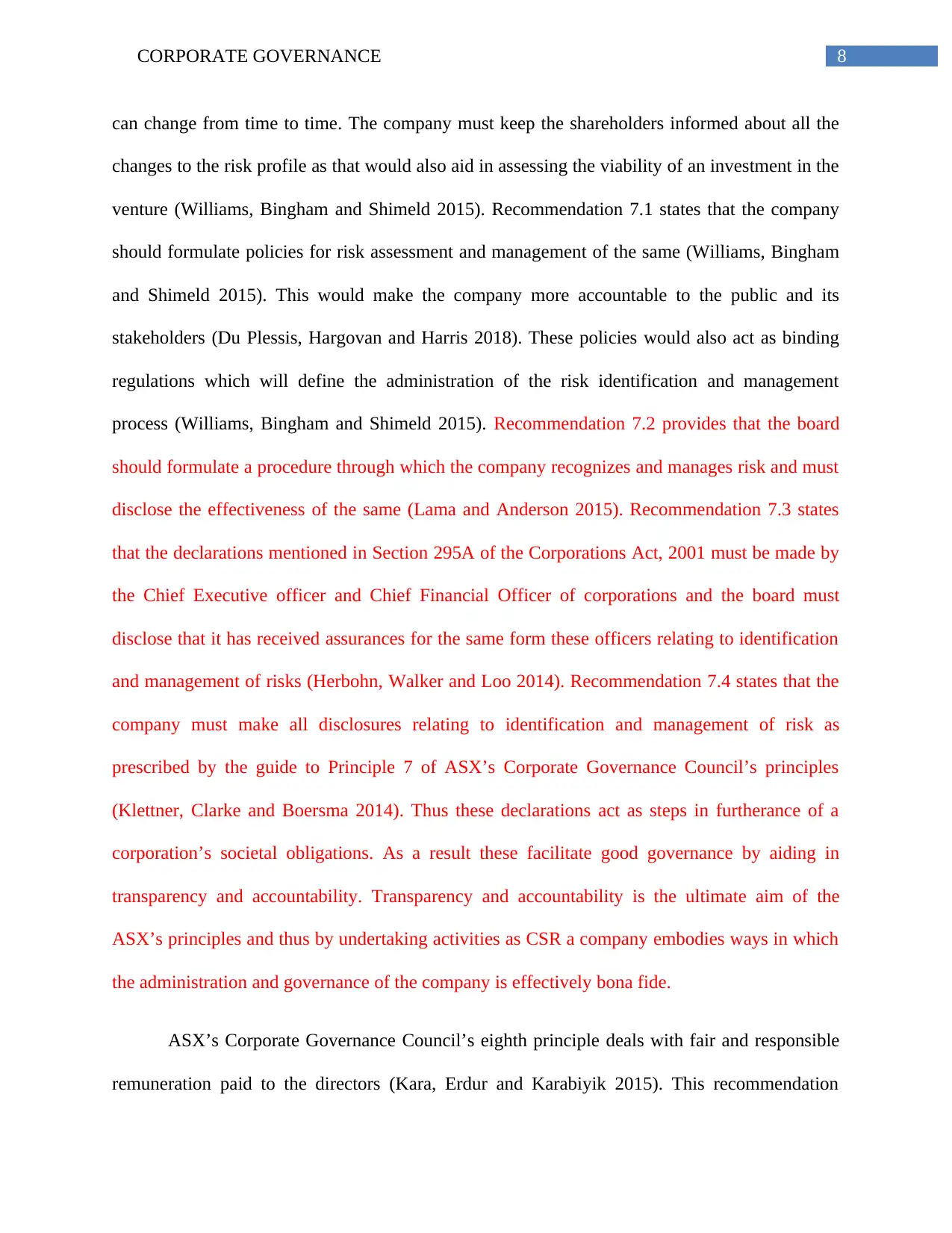
8CORPORATE GOVERNANCE
can change from time to time. The company must keep the shareholders informed about all the
changes to the risk profile as that would also aid in assessing the viability of an investment in the
venture (Williams, Bingham and Shimeld 2015). Recommendation 7.1 states that the company
should formulate policies for risk assessment and management of the same (Williams, Bingham
and Shimeld 2015). This would make the company more accountable to the public and its
stakeholders (Du Plessis, Hargovan and Harris 2018). These policies would also act as binding
regulations which will define the administration of the risk identification and management
process (Williams, Bingham and Shimeld 2015). Recommendation 7.2 provides that the board
should formulate a procedure through which the company recognizes and manages risk and must
disclose the effectiveness of the same (Lama and Anderson 2015). Recommendation 7.3 states
that the declarations mentioned in Section 295A of the Corporations Act, 2001 must be made by
the Chief Executive officer and Chief Financial Officer of corporations and the board must
disclose that it has received assurances for the same form these officers relating to identification
and management of risks (Herbohn, Walker and Loo 2014). Recommendation 7.4 states that the
company must make all disclosures relating to identification and management of risk as
prescribed by the guide to Principle 7 of ASX’s Corporate Governance Council’s principles
(Klettner, Clarke and Boersma 2014). Thus these declarations act as steps in furtherance of a
corporation’s societal obligations. As a result these facilitate good governance by aiding in
transparency and accountability. Transparency and accountability is the ultimate aim of the
ASX’s principles and thus by undertaking activities as CSR a company embodies ways in which
the administration and governance of the company is effectively bona fide.
ASX’s Corporate Governance Council’s eighth principle deals with fair and responsible
remuneration paid to the directors (Kara, Erdur and Karabiyik 2015). This recommendation
can change from time to time. The company must keep the shareholders informed about all the
changes to the risk profile as that would also aid in assessing the viability of an investment in the
venture (Williams, Bingham and Shimeld 2015). Recommendation 7.1 states that the company
should formulate policies for risk assessment and management of the same (Williams, Bingham
and Shimeld 2015). This would make the company more accountable to the public and its
stakeholders (Du Plessis, Hargovan and Harris 2018). These policies would also act as binding
regulations which will define the administration of the risk identification and management
process (Williams, Bingham and Shimeld 2015). Recommendation 7.2 provides that the board
should formulate a procedure through which the company recognizes and manages risk and must
disclose the effectiveness of the same (Lama and Anderson 2015). Recommendation 7.3 states
that the declarations mentioned in Section 295A of the Corporations Act, 2001 must be made by
the Chief Executive officer and Chief Financial Officer of corporations and the board must
disclose that it has received assurances for the same form these officers relating to identification
and management of risks (Herbohn, Walker and Loo 2014). Recommendation 7.4 states that the
company must make all disclosures relating to identification and management of risk as
prescribed by the guide to Principle 7 of ASX’s Corporate Governance Council’s principles
(Klettner, Clarke and Boersma 2014). Thus these declarations act as steps in furtherance of a
corporation’s societal obligations. As a result these facilitate good governance by aiding in
transparency and accountability. Transparency and accountability is the ultimate aim of the
ASX’s principles and thus by undertaking activities as CSR a company embodies ways in which
the administration and governance of the company is effectively bona fide.
ASX’s Corporate Governance Council’s eighth principle deals with fair and responsible
remuneration paid to the directors (Kara, Erdur and Karabiyik 2015). This recommendation
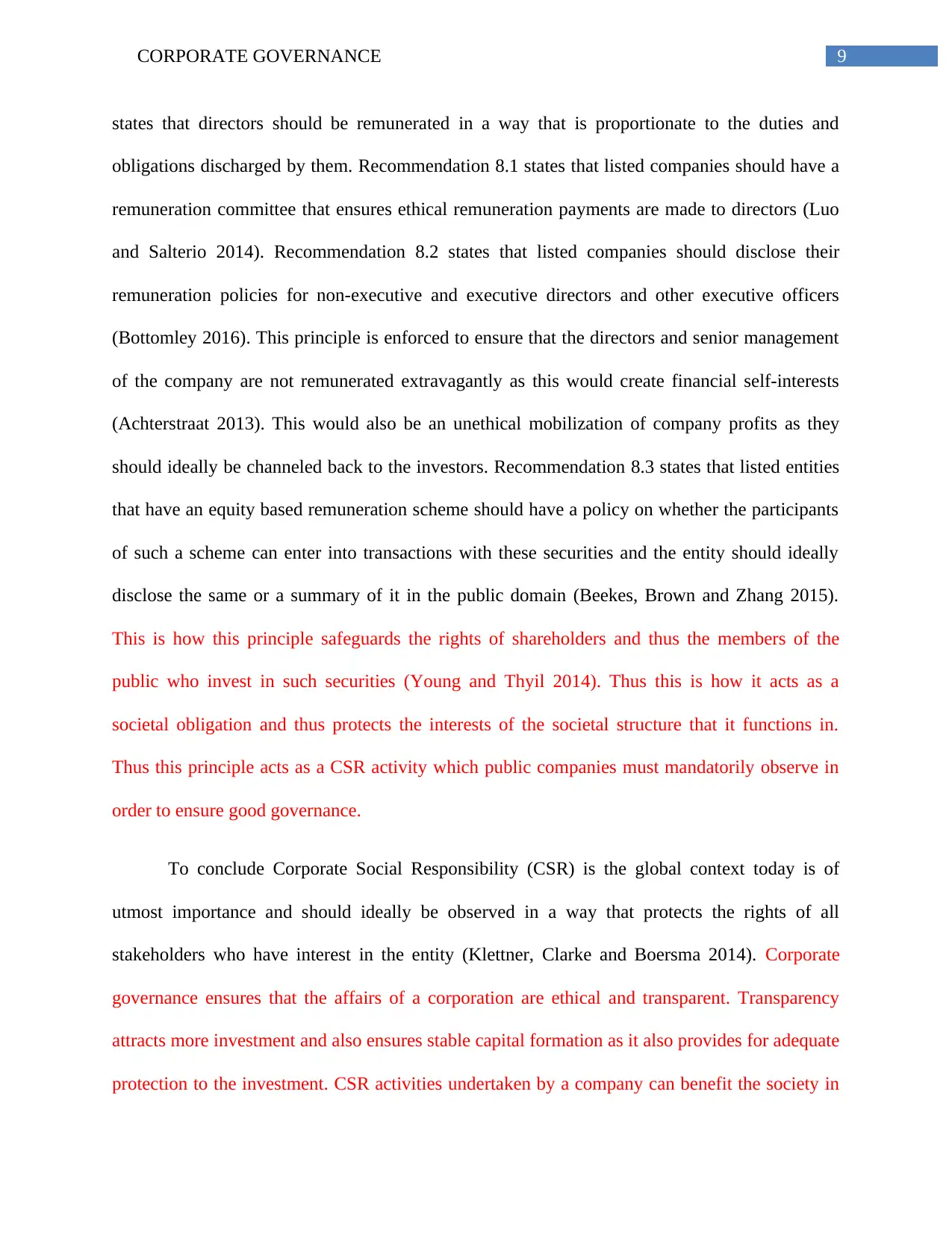
9CORPORATE GOVERNANCE
states that directors should be remunerated in a way that is proportionate to the duties and
obligations discharged by them. Recommendation 8.1 states that listed companies should have a
remuneration committee that ensures ethical remuneration payments are made to directors (Luo
and Salterio 2014). Recommendation 8.2 states that listed companies should disclose their
remuneration policies for non-executive and executive directors and other executive officers
(Bottomley 2016). This principle is enforced to ensure that the directors and senior management
of the company are not remunerated extravagantly as this would create financial self-interests
(Achterstraat 2013). This would also be an unethical mobilization of company profits as they
should ideally be channeled back to the investors. Recommendation 8.3 states that listed entities
that have an equity based remuneration scheme should have a policy on whether the participants
of such a scheme can enter into transactions with these securities and the entity should ideally
disclose the same or a summary of it in the public domain (Beekes, Brown and Zhang 2015).
This is how this principle safeguards the rights of shareholders and thus the members of the
public who invest in such securities (Young and Thyil 2014). Thus this is how it acts as a
societal obligation and thus protects the interests of the societal structure that it functions in.
Thus this principle acts as a CSR activity which public companies must mandatorily observe in
order to ensure good governance.
To conclude Corporate Social Responsibility (CSR) is the global context today is of
utmost importance and should ideally be observed in a way that protects the rights of all
stakeholders who have interest in the entity (Klettner, Clarke and Boersma 2014). Corporate
governance ensures that the affairs of a corporation are ethical and transparent. Transparency
attracts more investment and also ensures stable capital formation as it also provides for adequate
protection to the investment. CSR activities undertaken by a company can benefit the society in
states that directors should be remunerated in a way that is proportionate to the duties and
obligations discharged by them. Recommendation 8.1 states that listed companies should have a
remuneration committee that ensures ethical remuneration payments are made to directors (Luo
and Salterio 2014). Recommendation 8.2 states that listed companies should disclose their
remuneration policies for non-executive and executive directors and other executive officers
(Bottomley 2016). This principle is enforced to ensure that the directors and senior management
of the company are not remunerated extravagantly as this would create financial self-interests
(Achterstraat 2013). This would also be an unethical mobilization of company profits as they
should ideally be channeled back to the investors. Recommendation 8.3 states that listed entities
that have an equity based remuneration scheme should have a policy on whether the participants
of such a scheme can enter into transactions with these securities and the entity should ideally
disclose the same or a summary of it in the public domain (Beekes, Brown and Zhang 2015).
This is how this principle safeguards the rights of shareholders and thus the members of the
public who invest in such securities (Young and Thyil 2014). Thus this is how it acts as a
societal obligation and thus protects the interests of the societal structure that it functions in.
Thus this principle acts as a CSR activity which public companies must mandatorily observe in
order to ensure good governance.
To conclude Corporate Social Responsibility (CSR) is the global context today is of
utmost importance and should ideally be observed in a way that protects the rights of all
stakeholders who have interest in the entity (Klettner, Clarke and Boersma 2014). Corporate
governance ensures that the affairs of a corporation are ethical and transparent. Transparency
attracts more investment and also ensures stable capital formation as it also provides for adequate
protection to the investment. CSR activities undertaken by a company can benefit the society in
Secure Best Marks with AI Grader
Need help grading? Try our AI Grader for instant feedback on your assignments.
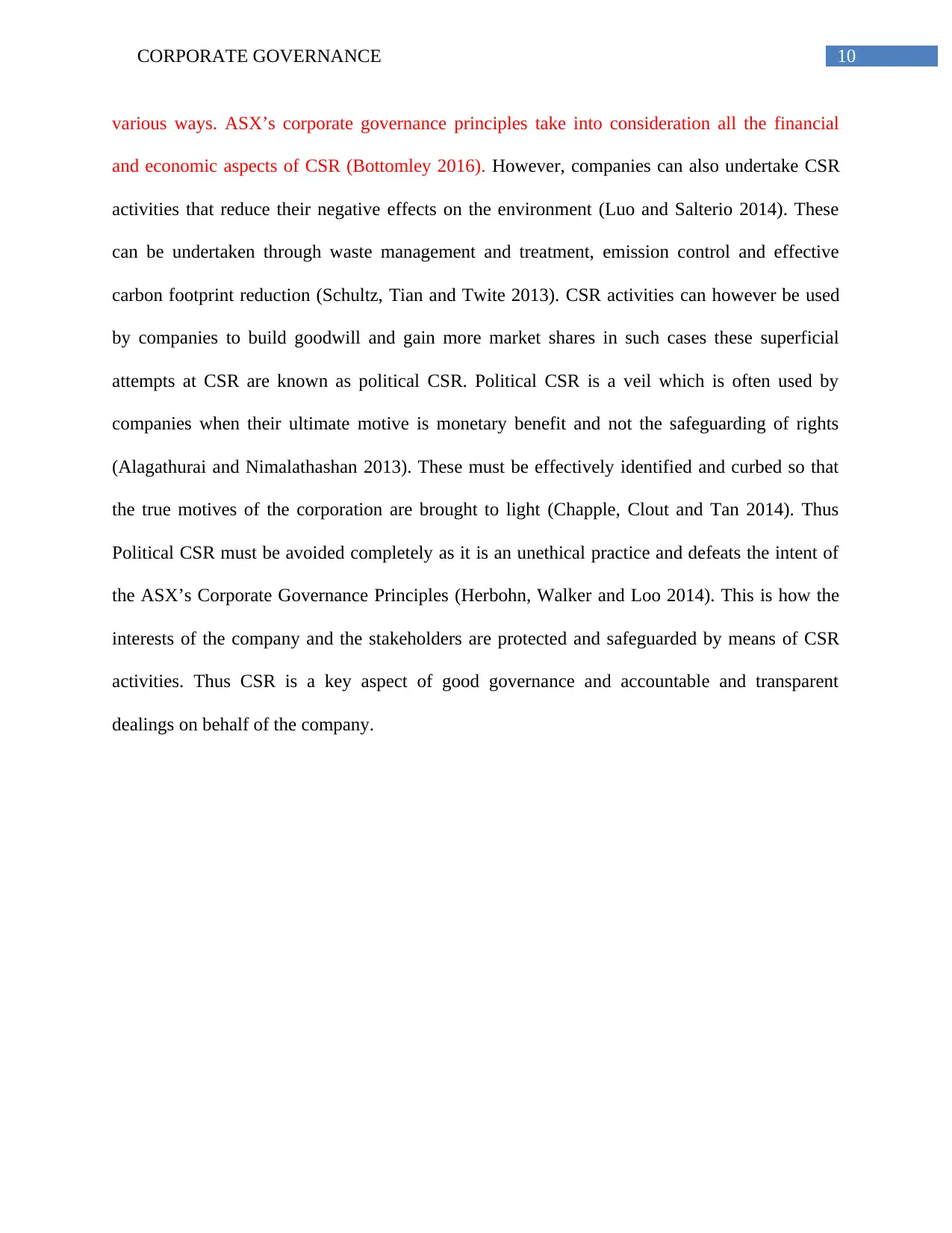
10CORPORATE GOVERNANCE
various ways. ASX’s corporate governance principles take into consideration all the financial
and economic aspects of CSR (Bottomley 2016). However, companies can also undertake CSR
activities that reduce their negative effects on the environment (Luo and Salterio 2014). These
can be undertaken through waste management and treatment, emission control and effective
carbon footprint reduction (Schultz, Tian and Twite 2013). CSR activities can however be used
by companies to build goodwill and gain more market shares in such cases these superficial
attempts at CSR are known as political CSR. Political CSR is a veil which is often used by
companies when their ultimate motive is monetary benefit and not the safeguarding of rights
(Alagathurai and Nimalathashan 2013). These must be effectively identified and curbed so that
the true motives of the corporation are brought to light (Chapple, Clout and Tan 2014). Thus
Political CSR must be avoided completely as it is an unethical practice and defeats the intent of
the ASX’s Corporate Governance Principles (Herbohn, Walker and Loo 2014). This is how the
interests of the company and the stakeholders are protected and safeguarded by means of CSR
activities. Thus CSR is a key aspect of good governance and accountable and transparent
dealings on behalf of the company.
various ways. ASX’s corporate governance principles take into consideration all the financial
and economic aspects of CSR (Bottomley 2016). However, companies can also undertake CSR
activities that reduce their negative effects on the environment (Luo and Salterio 2014). These
can be undertaken through waste management and treatment, emission control and effective
carbon footprint reduction (Schultz, Tian and Twite 2013). CSR activities can however be used
by companies to build goodwill and gain more market shares in such cases these superficial
attempts at CSR are known as political CSR. Political CSR is a veil which is often used by
companies when their ultimate motive is monetary benefit and not the safeguarding of rights
(Alagathurai and Nimalathashan 2013). These must be effectively identified and curbed so that
the true motives of the corporation are brought to light (Chapple, Clout and Tan 2014). Thus
Political CSR must be avoided completely as it is an unethical practice and defeats the intent of
the ASX’s Corporate Governance Principles (Herbohn, Walker and Loo 2014). This is how the
interests of the company and the stakeholders are protected and safeguarded by means of CSR
activities. Thus CSR is a key aspect of good governance and accountable and transparent
dealings on behalf of the company.
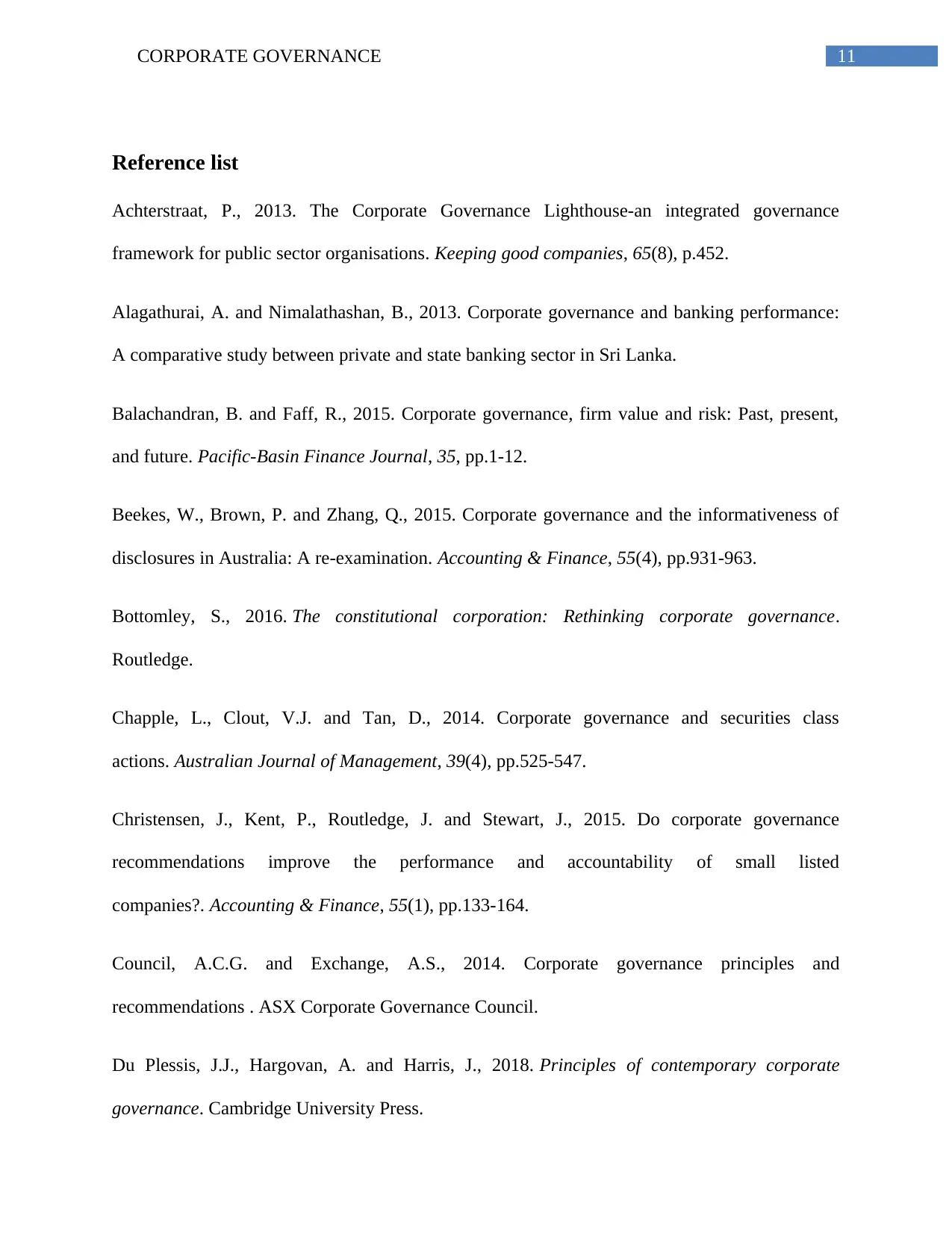
11CORPORATE GOVERNANCE
Reference list
Achterstraat, P., 2013. The Corporate Governance Lighthouse-an integrated governance
framework for public sector organisations. Keeping good companies, 65(8), p.452.
Alagathurai, A. and Nimalathashan, B., 2013. Corporate governance and banking performance:
A comparative study between private and state banking sector in Sri Lanka.
Balachandran, B. and Faff, R., 2015. Corporate governance, firm value and risk: Past, present,
and future. Pacific-Basin Finance Journal, 35, pp.1-12.
Beekes, W., Brown, P. and Zhang, Q., 2015. Corporate governance and the informativeness of
disclosures in Australia: A re‐examination. Accounting & Finance, 55(4), pp.931-963.
Bottomley, S., 2016. The constitutional corporation: Rethinking corporate governance.
Routledge.
Chapple, L., Clout, V.J. and Tan, D., 2014. Corporate governance and securities class
actions. Australian Journal of Management, 39(4), pp.525-547.
Christensen, J., Kent, P., Routledge, J. and Stewart, J., 2015. Do corporate governance
recommendations improve the performance and accountability of small listed
companies?. Accounting & Finance, 55(1), pp.133-164.
Council, A.C.G. and Exchange, A.S., 2014. Corporate governance principles and
recommendations . ASX Corporate Governance Council.
Du Plessis, J.J., Hargovan, A. and Harris, J., 2018. Principles of contemporary corporate
governance. Cambridge University Press.
Reference list
Achterstraat, P., 2013. The Corporate Governance Lighthouse-an integrated governance
framework for public sector organisations. Keeping good companies, 65(8), p.452.
Alagathurai, A. and Nimalathashan, B., 2013. Corporate governance and banking performance:
A comparative study between private and state banking sector in Sri Lanka.
Balachandran, B. and Faff, R., 2015. Corporate governance, firm value and risk: Past, present,
and future. Pacific-Basin Finance Journal, 35, pp.1-12.
Beekes, W., Brown, P. and Zhang, Q., 2015. Corporate governance and the informativeness of
disclosures in Australia: A re‐examination. Accounting & Finance, 55(4), pp.931-963.
Bottomley, S., 2016. The constitutional corporation: Rethinking corporate governance.
Routledge.
Chapple, L., Clout, V.J. and Tan, D., 2014. Corporate governance and securities class
actions. Australian Journal of Management, 39(4), pp.525-547.
Christensen, J., Kent, P., Routledge, J. and Stewart, J., 2015. Do corporate governance
recommendations improve the performance and accountability of small listed
companies?. Accounting & Finance, 55(1), pp.133-164.
Council, A.C.G. and Exchange, A.S., 2014. Corporate governance principles and
recommendations . ASX Corporate Governance Council.
Du Plessis, J.J., Hargovan, A. and Harris, J., 2018. Principles of contemporary corporate
governance. Cambridge University Press.
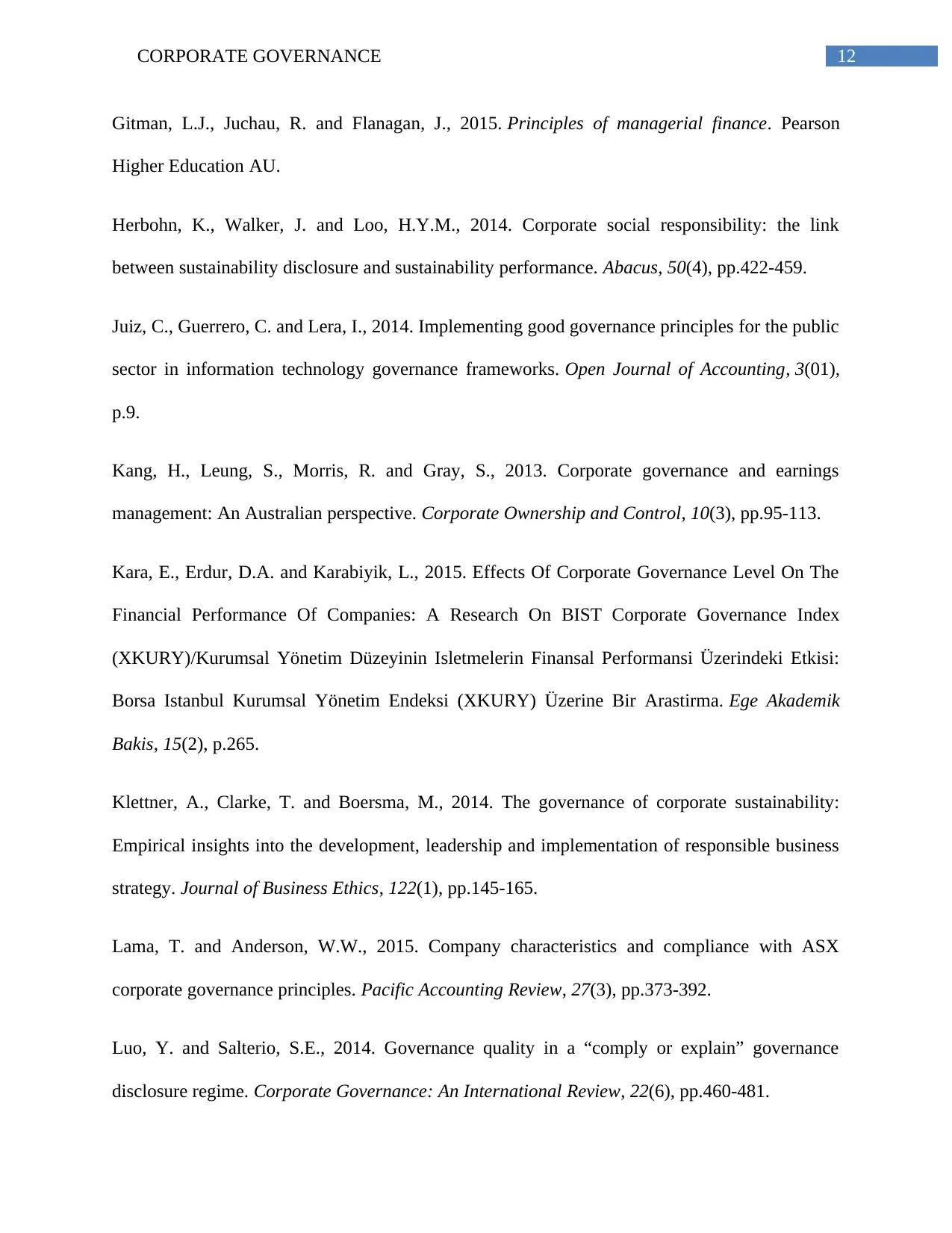
12CORPORATE GOVERNANCE
Gitman, L.J., Juchau, R. and Flanagan, J., 2015. Principles of managerial finance. Pearson
Higher Education AU.
Herbohn, K., Walker, J. and Loo, H.Y.M., 2014. Corporate social responsibility: the link
between sustainability disclosure and sustainability performance. Abacus, 50(4), pp.422-459.
Juiz, C., Guerrero, C. and Lera, I., 2014. Implementing good governance principles for the public
sector in information technology governance frameworks. Open Journal of Accounting, 3(01),
p.9.
Kang, H., Leung, S., Morris, R. and Gray, S., 2013. Corporate governance and earnings
management: An Australian perspective. Corporate Ownership and Control, 10(3), pp.95-113.
Kara, E., Erdur, D.A. and Karabiyik, L., 2015. Effects Of Corporate Governance Level On The
Financial Performance Of Companies: A Research On BIST Corporate Governance Index
(XKURY)/Kurumsal Yönetim Düzeyinin Isletmelerin Finansal Performansi Üzerindeki Etkisi:
Borsa Istanbul Kurumsal Yönetim Endeksi (XKURY) Üzerine Bir Arastirma. Ege Akademik
Bakis, 15(2), p.265.
Klettner, A., Clarke, T. and Boersma, M., 2014. The governance of corporate sustainability:
Empirical insights into the development, leadership and implementation of responsible business
strategy. Journal of Business Ethics, 122(1), pp.145-165.
Lama, T. and Anderson, W.W., 2015. Company characteristics and compliance with ASX
corporate governance principles. Pacific Accounting Review, 27(3), pp.373-392.
Luo, Y. and Salterio, S.E., 2014. Governance quality in a “comply or explain” governance
disclosure regime. Corporate Governance: An International Review, 22(6), pp.460-481.
Gitman, L.J., Juchau, R. and Flanagan, J., 2015. Principles of managerial finance. Pearson
Higher Education AU.
Herbohn, K., Walker, J. and Loo, H.Y.M., 2014. Corporate social responsibility: the link
between sustainability disclosure and sustainability performance. Abacus, 50(4), pp.422-459.
Juiz, C., Guerrero, C. and Lera, I., 2014. Implementing good governance principles for the public
sector in information technology governance frameworks. Open Journal of Accounting, 3(01),
p.9.
Kang, H., Leung, S., Morris, R. and Gray, S., 2013. Corporate governance and earnings
management: An Australian perspective. Corporate Ownership and Control, 10(3), pp.95-113.
Kara, E., Erdur, D.A. and Karabiyik, L., 2015. Effects Of Corporate Governance Level On The
Financial Performance Of Companies: A Research On BIST Corporate Governance Index
(XKURY)/Kurumsal Yönetim Düzeyinin Isletmelerin Finansal Performansi Üzerindeki Etkisi:
Borsa Istanbul Kurumsal Yönetim Endeksi (XKURY) Üzerine Bir Arastirma. Ege Akademik
Bakis, 15(2), p.265.
Klettner, A., Clarke, T. and Boersma, M., 2014. The governance of corporate sustainability:
Empirical insights into the development, leadership and implementation of responsible business
strategy. Journal of Business Ethics, 122(1), pp.145-165.
Lama, T. and Anderson, W.W., 2015. Company characteristics and compliance with ASX
corporate governance principles. Pacific Accounting Review, 27(3), pp.373-392.
Luo, Y. and Salterio, S.E., 2014. Governance quality in a “comply or explain” governance
disclosure regime. Corporate Governance: An International Review, 22(6), pp.460-481.
Paraphrase This Document
Need a fresh take? Get an instant paraphrase of this document with our AI Paraphraser
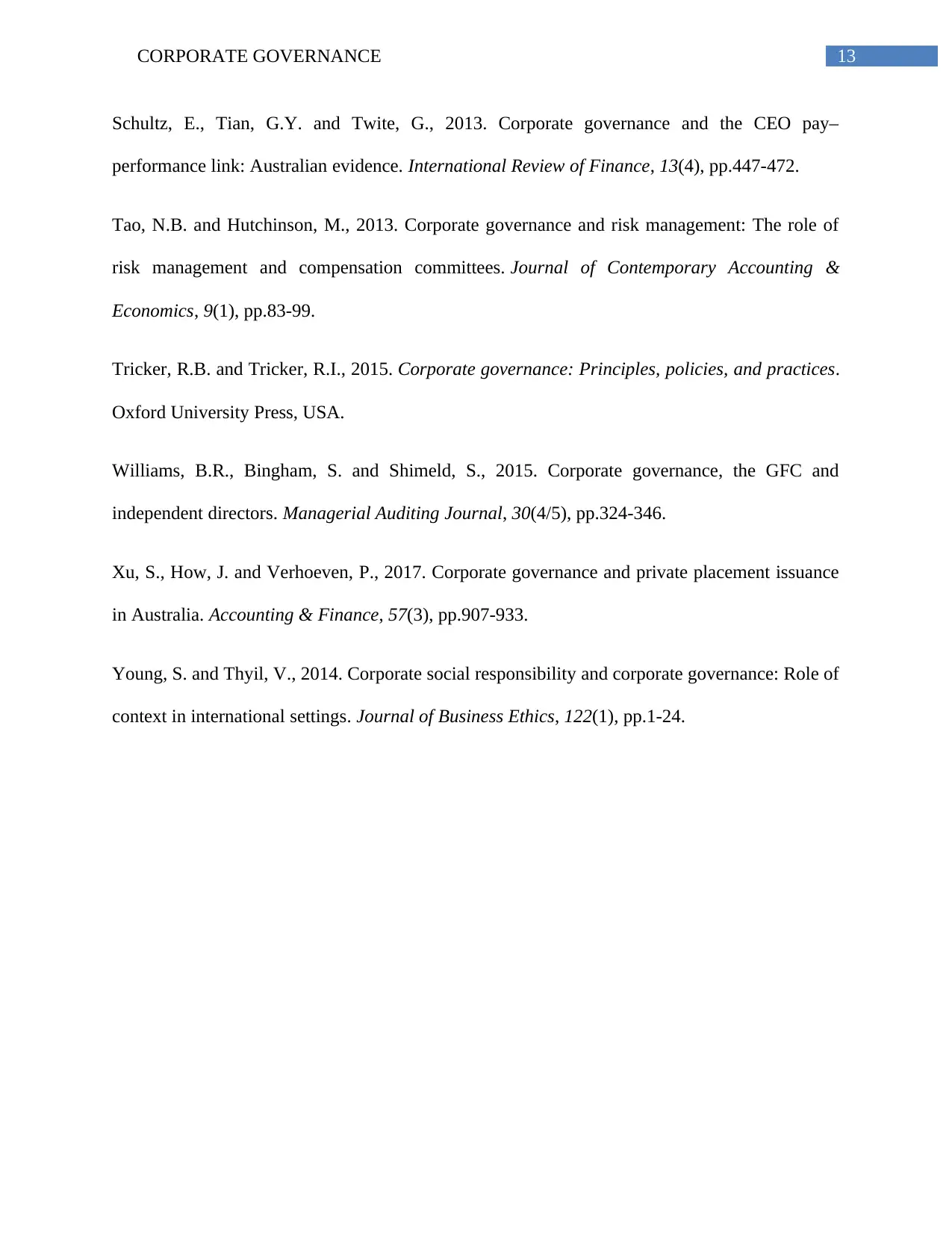
13CORPORATE GOVERNANCE
Schultz, E., Tian, G.Y. and Twite, G., 2013. Corporate governance and the CEO pay–
performance link: Australian evidence. International Review of Finance, 13(4), pp.447-472.
Tao, N.B. and Hutchinson, M., 2013. Corporate governance and risk management: The role of
risk management and compensation committees. Journal of Contemporary Accounting &
Economics, 9(1), pp.83-99.
Tricker, R.B. and Tricker, R.I., 2015. Corporate governance: Principles, policies, and practices.
Oxford University Press, USA.
Williams, B.R., Bingham, S. and Shimeld, S., 2015. Corporate governance, the GFC and
independent directors. Managerial Auditing Journal, 30(4/5), pp.324-346.
Xu, S., How, J. and Verhoeven, P., 2017. Corporate governance and private placement issuance
in Australia. Accounting & Finance, 57(3), pp.907-933.
Young, S. and Thyil, V., 2014. Corporate social responsibility and corporate governance: Role of
context in international settings. Journal of Business Ethics, 122(1), pp.1-24.
Schultz, E., Tian, G.Y. and Twite, G., 2013. Corporate governance and the CEO pay–
performance link: Australian evidence. International Review of Finance, 13(4), pp.447-472.
Tao, N.B. and Hutchinson, M., 2013. Corporate governance and risk management: The role of
risk management and compensation committees. Journal of Contemporary Accounting &
Economics, 9(1), pp.83-99.
Tricker, R.B. and Tricker, R.I., 2015. Corporate governance: Principles, policies, and practices.
Oxford University Press, USA.
Williams, B.R., Bingham, S. and Shimeld, S., 2015. Corporate governance, the GFC and
independent directors. Managerial Auditing Journal, 30(4/5), pp.324-346.
Xu, S., How, J. and Verhoeven, P., 2017. Corporate governance and private placement issuance
in Australia. Accounting & Finance, 57(3), pp.907-933.
Young, S. and Thyil, V., 2014. Corporate social responsibility and corporate governance: Role of
context in international settings. Journal of Business Ethics, 122(1), pp.1-24.
1 out of 14
Related Documents
Your All-in-One AI-Powered Toolkit for Academic Success.
+13062052269
info@desklib.com
Available 24*7 on WhatsApp / Email
![[object Object]](/_next/static/media/star-bottom.7253800d.svg)
Unlock your academic potential
© 2024 | Zucol Services PVT LTD | All rights reserved.





